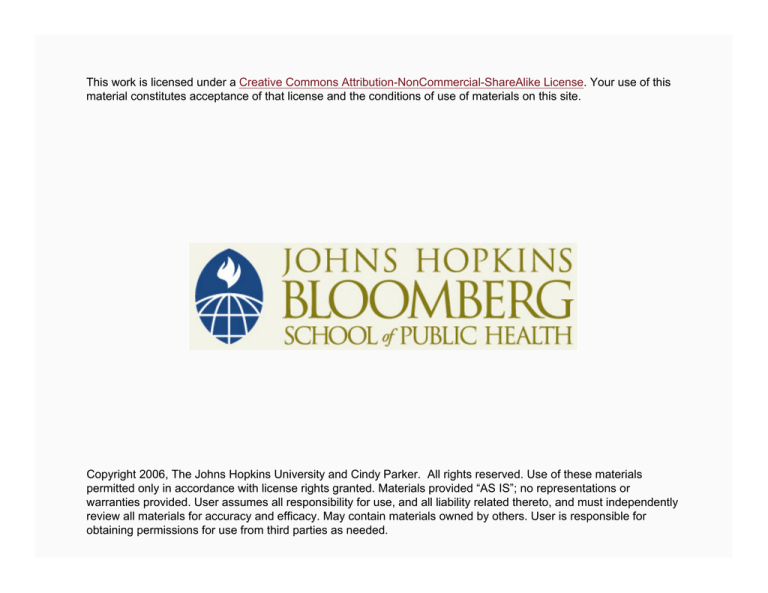
This work is licensed under a Creative Commons Attribution-NonCommercial-ShareAlike License. Your use of this
material constitutes acceptance of that license and the conditions of use of materials on this site.
Copyright 2006, The Johns Hopkins University and Cindy Parker. All rights reserved. Use of these materials
permitted only in accordance with license rights granted. Materials provided “AS IS”; no representations or
warranties provided. User assumes all responsibility for use, and all liability related thereto, and must independently
review all materials for accuracy and efficacy. May contain materials owned by others. User is responsible for
obtaining permissions for use from third parties as needed.
Introduction to Mental Health and Disaster
Preparedness
Cindy L. Parker MD, MPH
Johns Hopkins Center for Public Health Preparedness
Part 1 of 2
Overview
Other Modules in the Mental Health Series:
Mental Health Consequences of Disaster
Psychology of Terrorism
Self-care and Care for Caregiver
Disaster Mental Health Interventions
Strategic Planning
Crisis Communications
Psych First Aid: Competencies for Public Health Workers
Need for Disaster Mental Health Services
Need for public health to respond to disasters
Many more mental health injuries than physical injuries from
a disaster
Mental health of community will determine how resilient the
community is
Therefore, disaster mental health services are a vital
component of disaster planning for public health agencies.
Post-Disaster Mental Health “Surge”
Using just one example of a terrorism event, the sarin gas
release in Tokyo:
− 12 victims died
− 5,500 sought medical care
X Most had no sign of exposure
X Anxiety
X Most treated as outpatients and released
Meaning For Public Health
High ratio mental health casualties to physical casualties
Immediate post-disaster mental health services likely
delivered by non-MH personnel
PH Workers understand and provide needs of both
individuals and communities
With specialized training, provide basic crisis intervention
Crisis Intervention
Disaster mental health is a subset of crisis intervention.
Crisis intervention is well-documented to be effective in
reducing distress.
Photo by ob1left via flickr. Some rights reserved.
Psychological Crisis
Occurs when usual coping mechanisms fail
Results in impairment or dysfunction
Psychological Crisis
Can occur in an individual, organization, community, or
nation
Results in impairment or dysfunction
Need to mitigate the distress
Disaster Mental Health: Beginnings
1982 Air Florida Flight #90 took off from Washington DC’s
National Airport in a snowstorm and crashed into a bridge
sending passengers into an icy river.
Began to focus attention upon the psychological reactions of
disaster victims
And on the rescue personnel that tried to save them
Disaster Mental Health: Beginnings
International Critical Incident Stress Foundation (ICISF) in
1989
Advent of the disaster mental health networks of the
American Red Cross in 1992
Six Useful Guides to Disaster Mental Health Planning
DeWolfe, D. J. (2000). Field Manual for Mental Health and
Human Service Workers in Major Disasters (DHHS # ADM 90537). Wash., D.C.: SAMHSA, DHHS.
DHHS. (2004) Mental Health Response to Mass Violence and
Terrorism. DHHS # SMA 3959. Rockville, MD: Center for Mental
Health Services, SAMHSA.
Flynn, B. (2003). Mental Health All-Hazards Disaster Planning
Guidance. DHHS Pub. No. SMA 3829. Rockville, MD: Center for
Mental Health Services, SAMHSA.
Institute of Medicine. (2003). Preparing for the Psychological
Consequences of Terrorism. Wash, DC: Nat’l Academies Press.
National Institute of Mental Health (2002). Mental Health and
Mass Violence. Wash. D.C.: Author.
Ritchie, E.C., Friedman, M., Watson, P., Ursano, R., Wessely, S. &
Flynn, B. (2004). Military Medicine, 169, 575-579.
Lesson #1 Gleaned from these Works for Public Health
1. Disaster mental health intervention should assist victims to
meet basic needs first
− Family reunification
− Food
− Water
− Shelter
− Alleviation of pain
− Safety and Security
Photo by SF Drew via flickr. Some rights reserved.
Lesson #2
2. Disaster mental health services should be:
− Phase sensitive
− Multi-modal
− Intervention system
Lesson #3
3. Such a system might include:
− Assessment and triage
− Strategic planning
− Psychoeducation and anticipatory guidance
− Liaison, advocacy, and reunification, or building, of
familial and social support networks
− Individual clinical intervention
− Small group intervention
− Large group intervention, e. g, “town meetings” and
respite areas for emergency response personnel
− Follow-up and referral
Lesson #4
4. Disaster mental health is only one point on a continuum of
psychological care.
− Not a substitute for psychotherapy
− Facilitate access to next level of care
Disaster Mental Health and Terrorism
Terrorism: The use of force or violence, or threatened use of
force or violence, against persons and places for the purpose
of intimidating and/or coercing a government, its citizens,
or any segment thereof for political or social goals (as defined
by FBI).
Recent Events: Evidence of Successful Disaster Mental Health
Boscarino, et al, 2005
1681 New York adults after 9/11
2 year follow up
Crisis interventions resulted in
− ↓ binge drinking and alcohol
dependence
− ↓ PTSD symptoms
− ↓ major depression
− ↓ anxiety
Photo by absolutwade via flickr. Some rights reserved.





